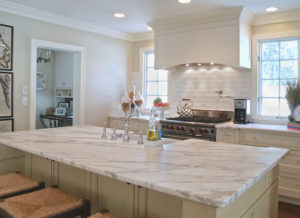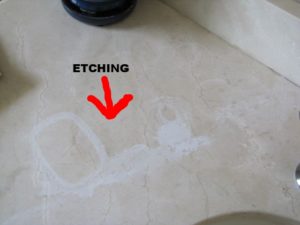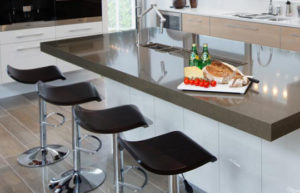Read Part 1 of this series.
Marble
If you want to impart a luxurious and classic look into your kitchen or bathroom, this is the stone for you. It does require a bit more tlc than granite but properly cared for it will give you decades of use.
Attributes of marble countertops
- A beautiful, solid stone material mined from quarries from around the world
- Available in a wide spectrum of colors from whites, creams, beiges, greys, rust, gold and black
-
Coloring tends to be fairly consistent with veins of concentrated color running through
- It’s available in a wide variation of finishes such as leather, brushed and honed (aka suede) and of course, the traditional polished finish. TIP: Each manufacturer may have their own name for each finish and may not offer every one
- It makes a great accent on an island or wet bar, if your budget won’t stretch to using it on all your countertops
- Slightly softer than granite but still offers good durability
- Look for the marble that is mined on Vancouver Island
Things to know about marble
- Requires a similar type of care to granite. With some TLC both granite and marble will keep their fantastic looks for years
-
It’s porous and will therefor stain without proper sealing
- Be prepared to seal your countertops every 1-2 years
- It’s especially vulnerable to acidic foods and liquids, which will etch it. TIP: Etching will be less noticeable on white marble than other colors
- Care for your marble by keeping it sealed, avoiding acidic material and wiping spills up quickly
Costs
- See costs for engineered stone
Engineered Stone
This man-made material is commonly known as quartz countertops, due to its high content of crushed quartzite. It’s a good choice if you are looking for consistent coloration and pattern.
Attributes of engineered stone
- Also known as Quartz and manufactured around the world by companies such as Silestone, Caesarstone, Hanstone, Cambria, and Icestone to name a few
- It was originally developed in 1963 in Italy as Bretonstone, and was designed for use as floor tiles
- Manufactured from 80-92% crushed quartzite, mixed with pigment for color and polyresin as a binder
- Engineered stone is used in about 70% of the kitchens of the supplier that we spoke to
-
Rich and luxurious in appearance it’s great for contemporary homes with its modern look and consistent color and patterning
- There is a wide range of color choice and pattern. Some of which can mimic traditional marble, granite and limestone or have their own unique patterns and effects such mirror flecks or speckles
- Available in a wide variation of finishes such as leather, brushed and honed (suede) as well as the traditional polished finished. TIP: A honed finished is higher maintenance as it shows marks more easily
- Seams can be less noticeable due to more consistent coloring
- Some manufacturers offer integral sinks made out of engineered stone for a seamless look. TIP: This would make bathroom sink cleaning a breeze
- It has a softer feel than other solid countertop materials
- Very durable yet also more forgiving and doesn’t chip or crack easily
- Has a non-porous finish that is extremely stain resistant without the need to seal the surface
- Canadian manufacturer, Hanstone makes the majority of their products in Ontario with Canadian quartz
Things to know about engineered stone
- Not as resistant to heat. Take care with hot pots and hair-styling tools
Costs
- Price ranges from $85-$200 per sq ft. TIP: The complexity of the job, number of seams , corners, and the style of the edge profile will impact countertop costs too
- Standard eased edge is the standard profile. There are several others to choose from costing around $30-$40 extra per linear foot
- Consider fluting beside your sink. This is where the fabricator creates channels in the countertop similar to a built-in drain-board
Continued in Part 3




